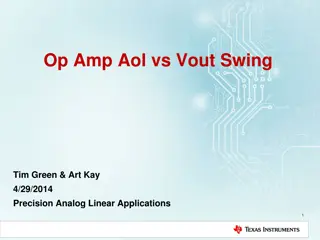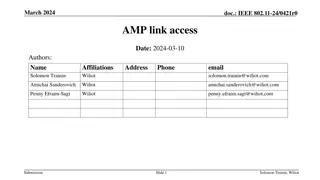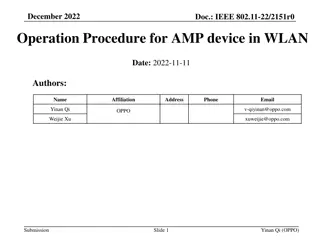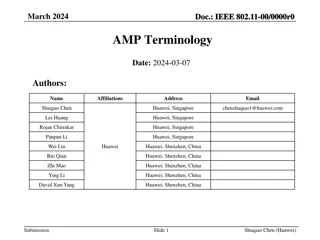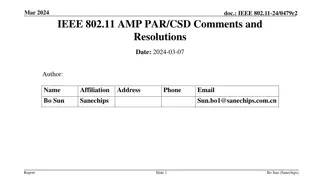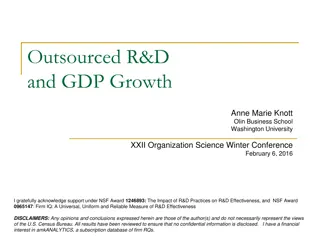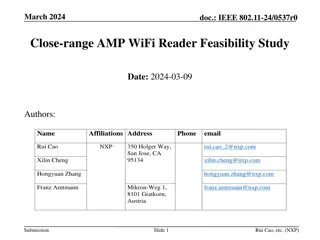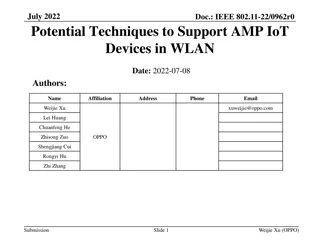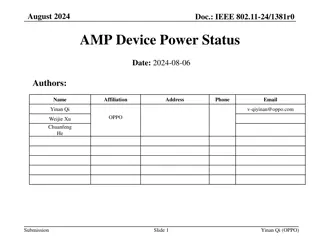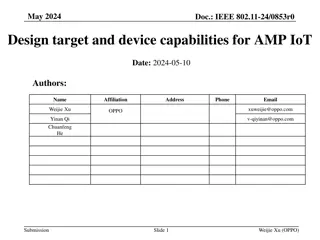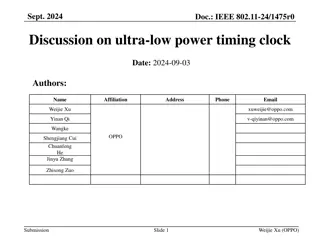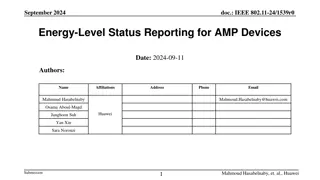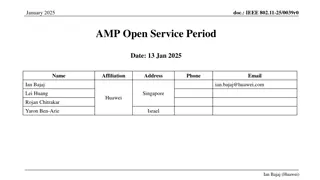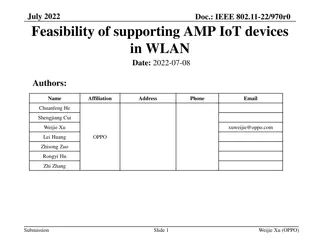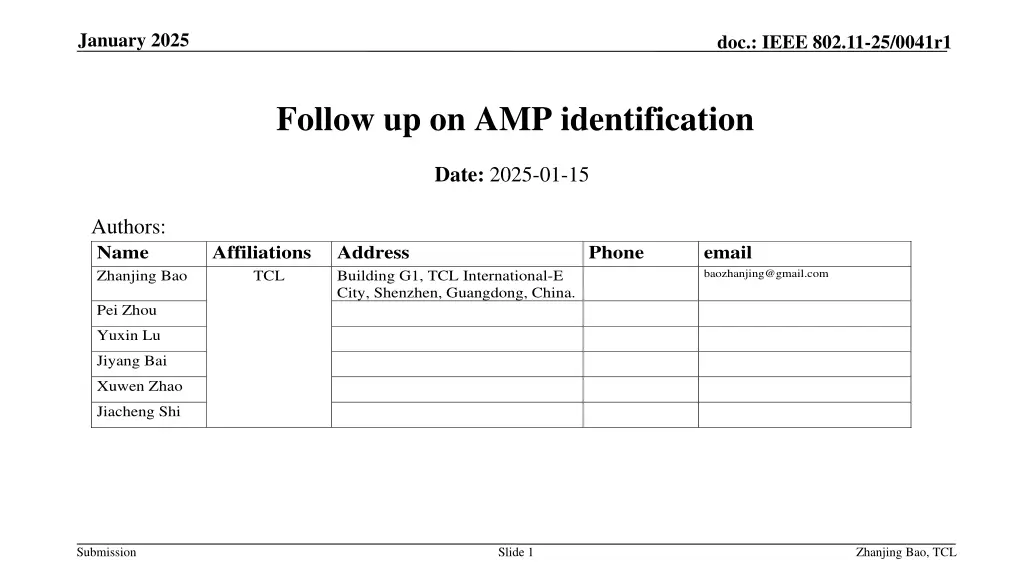
IEEE 802.11-25/0041r1 Follow-Up on AMP Identification
Explore the intricate details of AMP device identification within the IEEE 802.11-25/0041r1 document. Understand AMP STA capabilities, transmission methods, and the significance of AMP device differentiation for effective scheduling and management in wireless networks.
Download Presentation

Please find below an Image/Link to download the presentation.
The content on the website is provided AS IS for your information and personal use only. It may not be sold, licensed, or shared on other websites without obtaining consent from the author. If you encounter any issues during the download, it is possible that the publisher has removed the file from their server.
You are allowed to download the files provided on this website for personal or commercial use, subject to the condition that they are used lawfully. All files are the property of their respective owners.
The content on the website is provided AS IS for your information and personal use only. It may not be sold, licensed, or shared on other websites without obtaining consent from the author.
E N D
Presentation Transcript
January 2025 doc.: IEEE 802.11-25/0041r1 Follow up on AMP identification Date: 2025-01-15 Authors: Name Zhanjing Bao Affiliations TCL Address Building G1, TCL International-E City, Shenzhen, Guangdong, China. Phone email baozhanjing@gmail.com Pei Zhou Yuxin Lu Jiyang Bai Xuwen Zhao Jiacheng Shi Submission Slide 1 Zhanjing Bao, TCL
January 2025 doc.: IEEE 802.11-25/0041r1 Motivation During the study group stage, we discussed different AMP device types, AMP-only devices and AMP- assisted devices. Correspondingly, four transmission methods have been proposed, Backscatter-close range Backscatter-long range Active TX Legacy enhanced Based on this, many contributions[3]-[7] are discussing the different PHY/MAC/energizing capabilities supported by AMP functional entities. For AMP functional entities with different capabilities, different transmission methods and channel access methods[8]-[13] are required. Based on the identification of AMP STA, AMP APs or readers obtaining the capability or existence information of AMP STAs can help implement more effective scheduling and management. To enable coexistence, flexible scheduling and management, AMP identification can include Identify AMP devices (distinguished from legacy STAs) Identify different types of AMP devices Submission Slide 2 Zhanjing Bao, TCL
January 2025 doc.: IEEE 802.11-25/0041r1 AMP STA identification For AMP STAs which are unable to initiate transmission through EDCA, the AMP STA capability collection should be initiated by the AMP AP or reader. AMP STAs which can obtain transmission opportunities on their own can follow the existing association way. protection window Control/management frame READER The capability reporting can be used for AMP STA identification, which allows the reader to learn about the AMP STA s existence and capabilities For devices that cannot/do not require capability reporting, it is only necessary to declare their existence to achieve identification just a simple response The capability information is TBD, and may include data rate, WPT capability, support for TWT, etc, Capability element Or a simple response to indicate existence Response AMP STA #1 Not allowed to access Legacy STA Submission Slide 3 Zhanjing Bao, TCL
January 2025 doc.: IEEE 802.11-25/0041r1 Identification vs. Association For the .11 association, in general AP and STAs exchange capabilities AP assigns AID to STA Association is always initiated by the non-AP STA, not the AP For the AMP STA capability report, AMP Non-AP STAs perform capability or existence reporting, and AP capability exchange is not necessary The allocation of identifiers is optional Capability collection is initiated by the AMP AP / reader AP sends a control frame or a management frame to indicate the protection window for capability reporting to AMP STA Within an identification protection window, multiple capability collections of AMP STA can be conducted. AP or reader can decide the number of times to trigger capability reporting within the protection window, and can also terminate the protection window in advance when no response is received from AMP STA after multiple triggers Periodic identification can be scheduled based on broadcast TWT or r-TWT, etc Indicate the protection window slot info... Indicate the remaining protection window slot info... protection window 1st Trigger frame 2nd Trigger frame ack ack READER Response AMP STA #1 Response AMP STA #2 *Taking trigger frames as an example here Submission Slide 4 Zhanjing Bao, TCL
January 2025 doc.: IEEE 802.11-25/0041r1 ID allocation for AMP STA The assigned ID is featured by Shorter length than AMP STA s own identifier (device code\MAC address) usage within the scope of AP Conditions for ID allocation to AMP STA AMP STA can store assigned ID(s), i.e. with memory capability AMP STA has a unique identifier (device code\MAC address) Map with the ID assigned by AP One to many Long term communication scenarios that require maintenance or detection of link status other conditions could be further discussed The assigned ID can be used for device grouping and access restrictions, which is beneficial for Improving the reliability of AMP IoT More precise scheduling, control and management Maintenance and updating of device information and link status Improving transmission efficiency Submission Slide 5 Zhanjing Bao, TCL
January 2025 doc.: IEEE 802.11-25/0041r1 Summary In [1], we have a preliminary discussion on the necessity and methods of capability reporting and ID allocation for AMP STAs. In [2], we further discussed Details of the capability reporting for AMP STA Details of the ID allocation for AMP STA ID conflict avoidance and ID update In this contribution, we have clarified and summarized the motivation, methods, and benefits of AMP identification, and proposed relevant SPs. Submission Slide 6 Zhanjing Bao, TCL
January 2025 doc.: IEEE 802.11-25/0041r1 SP1 Do you agree to add the following text to TGbp SFD? 11bp supports a MAC mechanism to enable AMP STAs to report their existence or capabilities if needed. The detailed capability information is TBD. Y/N/A Submission Slide 7 Zhanjing Bao, TCL
January 2025 doc.: IEEE 802.11-25/0041r1 SP2 Do you agree to add the following text to TGbp SFD? 11bp supports a MAC mechanism to enable an ID to be assigned to an AMP STA based on its reported existence. Conditions for ID allocation are TBD. Y/N/A Submission Slide 8 Zhanjing Bao, TCL
January 2025 doc.: IEEE 802.11-25/0041r1 References [1] 11-24-1194-00-00bp-capability-report-for-AMP-STA [2] 11-24-1560-00-00bp-Follow-up-on-capability-report-and-ID-allocation-for-AMP-STA [3] 11-24-0867-00-00bp-thoughts-and-questions-on-amp-phy [4] 11-24-0853-00-00bp-design-target-and-device-capabilities-for-amp-iot [5] 11-24-1794-00-00bp-Robust Method for AMP Active Uplink Multiple Data Rate Support [6] 11-25-33-01-00bp-UL Data Rates for AMP [7] 11-24-1767-00-00bp-AMP Energizer [8] 11-24-1805-00-00bp-AMP Time-based channel access discussions [9] 11-24-1806-00-00bp-AMP Time-based channel access for active tags [10] 11-25-45-00-00bp-Channel access for Backscatter non-AP AMP STAs [11] 11-25-46-00-00bp-Channel access for Active Tx non-AP AMP STAs [12] 11-24-1775-01-00bp-Duty-cycle AMP operation [13] 11-24-1774-01-00bp-Details of AMP trigger procedure ... Submission Slide 9 Zhanjing Bao, TCL
January 2025 doc.: IEEE 802.11-25/0041r1 Appendix(1/3): AP as reader-ID allocation method a & b When AMP AP acts as a reader, there are two options for further ID allocation based on the identification of AMP STAs AMP AP or reader can immediately assign an ID to AMP non-AP STA upon receiving its response (method a), or it can assign IDs upon receiving multiple responses (method b). protection window Trigger ID allocation Trigger ID allocation READER AMP STA #1 doze/sleep Response AMP STA #1 AMP STA #1 doze/sleep AMP STAs that receive ACK or ID should not respond to subsequent Trigger frames. Energy-sensitive devices can switch to PS mode within the remaining protection window Reduce the collision probability of subsequent response frames sent by other AMP STAs Response AMP STA #2 Method a protection window Trigger ack Trigger ack ID allocation READER If there are multiple readers,there are two options for the assigned ID Independent ID: To avoid ID conflicts,AMP STA stores the ID and its source information( such as the reader s MAC address or BSS ID). When the reader changes, it can obtain a new ID from a new reader Global ID: when the reader changes, AMP STA will indicate the existing ID through a response frame, whileAMP AP and AMP STA can negotiate whether existing IDs need to be modified AMP STA #1 Listening mode Response AMP STA #1 AMP STA #2 Listening mode Response AMP STA #2 Method b Submission Slide 10 Zhanjing Bao, TCL
January 2025 doc.: IEEE 802.11-25/0041r1 Appendix(2/3): non-AP STA as reader-ID allocation method c A non-AP STA acts as a reader, similar to a relay node. AP reader AMP STA AMP STA Identification initiated Capability collection can be initiated by the reader or AP. trigger response ack After receiving multiple responses, the reader can forward the information of AMP STA to AP for ID allocation. Protection window trigger response ack Due to the unified allocation of IDs by AMP AP, even if multiple readers exist, there will be no ID conflicts. AMP STA info report ID allocation ID allocation Referring to .11 association procedure, there is also a limit to the number of IDs allocated by readers or AMP APs. AMP AP should be able to update and reassign IDs AMP STA should be able to determine whether the assigned ID is still valid Submission Slide 11 Zhanjing Bao, TCL
January 2025 doc.: IEEE 802.11-25/0041r1 Appendix(3/3): ID update Due to some AMP STAs being unable to actively send association requests, we have designed a trigger based identification method in our contribution. Similarly, referring to the disassociation procedure, AMP STA may not be able to actively send disassociation request frame and may directly leave the transmission area of the current reader. For AMP AP or reader: The ID assigned to AMP STA can be lifetime or short-term valid The identification and polling of AMP STA should be periodic If the AMP AP unicast control frames to a AMP STA multiple times based on the assigned ID but does not receive a response, the AMP AP will reclaim and reassign this ID For AMP non-AP STA: When the ID becomes invalid or be reassigned, the AMP STA should respond to the identification initiated by the AMP AP again to reacquire the ID Submission Slide 12 Zhanjing Bao, TCL



